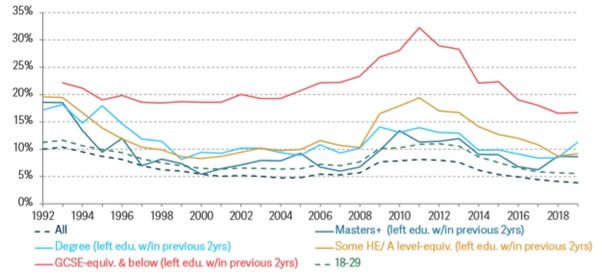
Professor Anne Green looks at both the short and longer-term effects that COVID-19 will have on youth employment levels, as well as the influence different levels of education will have on this.
Getting On The Career Ladder – Challenges for the Young
When unemployment rates were relatively low and employment rates high a key concern amongst labour market commentators and policy analysts was ‘climbing the ladder’ to achieve progression in work. In the context of continued demand for low-skilled job roles in the economy and a growth in higher-skilled jobs the decline in traditional middle-skilled clerical and blue-collar jobs meant that there were fewer ‘middle rungs’ on the ladder of job progression. With the changed economic circumstances of the Covid-19 pandemic, the emphasis shifts back to ‘getting on the ladder’ (i.e. accessing employment).
The Resolution Foundation has published a report on prospects for and challenges faced by education leavers in the context of the Covid-19 crisis. As noted by the Institute for Fiscal Studies and as set out in a previous feature on unemployment and labour market policy priorities young people are hit disproportionately hard in economic downturns. It is those with fewer qualifications who fare worst of all.
The Influence of Education on Youth Employment
The Resolution Foundation’s analysis of the unemployment rate in the wake of the Financial Crisis shows that the unemployment rate rose more for 18-29 years olds than for all age groups and that those individuals who had left education in the previous two years saw marked increases in unemployment (see Figure 1). Between 2008 and 2011 unemployment for education leavers with lower-level qualifications (GCSE equivalent and below) rose from 23% to 32%, while for those with mid-level qualifications (some higher education/A level-equivalent) the unemployment rate rose from 10% to 19%. While graduates also saw increases in unemployment the scale was much less marked than for non-graduate recent education leavers.

Using data from the Labour Force Survey and projections of marked unemployment increases from Q2 2019 to Q2 2020 from the Office for Budget Responsibility, the Resolution Foundation has estimated likelihoods of being employed from one year after leaving education. The estimated employment rates in the COVID-19 scenario are 66% for those with higher-level qualifications (compared with a counterfactual of 83%), 64% for those with mid-level qualifications (compared with a counterfactual of 73%) and 54% for those with lower-level qualifications (compared with a counterfactual of 54%). These are large reductions in estimated employment rates for all three groups of education leavers. But it is what happens next where the differentials between the groups are most marked: for graduates ‘scarring effects’ end after four years, but for non-graduates they persist for longer.
The Resolution Foundation points to a triple whammy for low-qualified education leavers:
- They are more likely in ‘non-crisis’ circumstances to work in lower-paid and less secure job roles
- They are less likely to find employment in a crisis than in non-crisis conditions
- Due to the nature of sectoral shutdowns in the COVID-19 crisis (e.g. in hospitality – which is an important sector for labour market entry and for young people’s employment generally) lower-qualified leavers may be less likely to find employment quickly after entering the jobs market than in previous recessions
So the features of the COVID-19 crisis that make it different from previous crises (see Box 1) are likely to work to accentuate disadvantages faced by low-qualified leavers.
Box 1: Previous recessions and COVID-19 crisis features
| Common features of recessions | Distinctive features of Covid-19 crisis |
| High unemployment | ‘Shutdowns’ of some sectors (e.g. much of hospitality) |
| Fewer job openings | School, college and university closures (with some substitution of online learning) |
The Effect On the West Midlands
So what does this mean for the West Midlands? Figure 2 shows the trend in claimants aged 18-24 over the period to March 2020 (i.e. before the main large increases in claims related to the Covid-19 crisis). However, it is clear that the number of claimants was already a slow upward trend before the Covid-19 crisis and that the claimant rate was higher regionally than nationally.

Despite improvements in qualification levels, it also remains the case that the West Midlands has more individuals with lower-level qualifications and fewer with high-level qualifications than nationally, so indicating that a larger than average share of young people face amongst the greatest challenges faced by education. This indicates that the challenge of young people leaving education ‘getting on the ladder’ is set to be more marked in the West Midlands than nationally.
In previous recessions, some young people have remained in education at a time of crisis. This suggests that an increase in young people in full-time education in further education and higher education might be expected. But in the context of the COVID-19 crisis, there is a lack of face-to-face advice and guidance and also on opportunities for networking. Moreover, learners have missed out on some learning (despite a move to some remote learning). This raises questions of:
- How can young people/ education leavers be supported to navigate changing opportunities?
- How well equipped is the skills and learning system to respond to the crisis?
- What is the ability of different parts of the education system to absorb greater numbers of recruits from September 2020?
There is also an issue currently and over the short-term of access to apprenticeships. Data on apprenticeship starts shows an increase of 10.2% in apprenticeship starts in the West Midlands Metropolitan Area between 2017/18 and 2018/19. This overall increase disguises a decrease in Intermediate Apprenticeships and an increase in Advanced Apprenticeships and especially Higher Apprenticeships. So while apprenticeship opportunities for more qualified individuals have been increasing for those individuals with fewer qualifications – especially younger people – apprenticeship opportunities have decreased – and markedly so since 2016/17.
The lockdown has had a marked impact on apprenticeship starts. 304 providers nationally responding to a request for data from FE Week indicated that of 13,732 apprenticeship starts expected in April 2020, only 2,693 were achieved (i.e. just under 20% of those expected). The lockdown also impacts on opportunities for work experience and work-based learning – which can be important in helping individuals to access jobs. In an environment where there is social distancing as businesses return:
- What will be the appetite for taking on apprentices – especially in sectors less well suited to remote learning?
- What opportunities will there be for young people to get important experience in the workplace?
References:
Henehan K (2020) Class of 2020: Education leavers in the current crisis, Resolution Foundation, London.
City-REDI / WM REDI have developed a resource page with all of our analysis of the impact of Coronavirus (COVID-19) on the West Midlands and the UK. It includes previous editions of the West Midlands Weekly Economic Monitor, blogs and research on the economic and social impact of COVID-19. You can view that here.
This blog was written by Professor Anne Green, Professor of Regional Economic Development, City-REDI / WM REDI, University of Birmingham.
To sign up for our blog mailing list, please click here.
Disclaimer:
The views expressed in this analysis post are those of the authors and not necessarily those of City-REDI / WM REDI or the University of Birmingham
